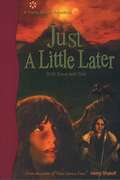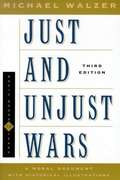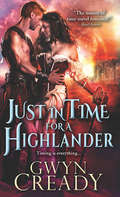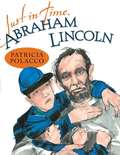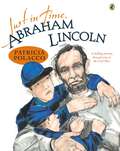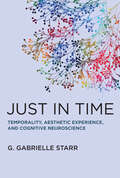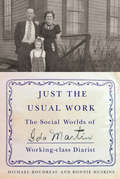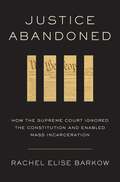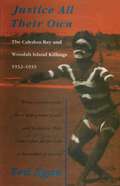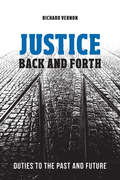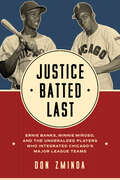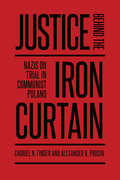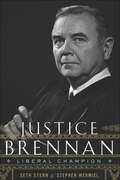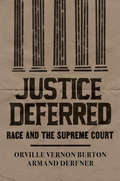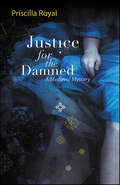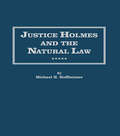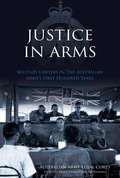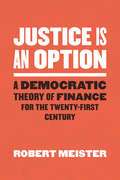- Table View
- List View
Just a Little Later With Eevo and Sim
by Henry Shykoff Marilyn Mets Peter LedwonJust a Little Later With Eevo and Sim is the continuation of Once Upon a Time Long, Long Ago, the adventures of Eevo and Sim. The story is set about 50,000 years ago in the time of prehistoric man. Their parents, Shim and Dedu, have just returned from their long trip to the Wetlands Clan, the former home of Shim. They discover that, together, Eevo and Sim had overcome many dangers, discovered fire, rescued two wolf cubs and saved their home from starvation.Now Sim and Eevo are off on a long, dangerous journey back to the Wetlands Clan, accompanied by the wolves. Caught in a fierce sandstorm, they are separated from Shim and Dedu. Once again, this sister and brother take on many challenges, make new discoveries, and even encounter the Great One: the much-feared crocodile of the Great River."Once Upon a Time Long, Long Ago was an incredibly popular book in my school library. The continuing tale, Just a Little Later With Eevo and Sim, proves to be an equally exciting story. Students from grades 3 to 8 will be enthralled by the adventures these two siblings encounter. From designing water bags made from an elk’s stomach to figuring out a way to capture a gigantic crocodile; from teaching the secret of fire making to planning how to hunt wild horses, Sim and Eevo prove how valuable they are to the clan. Both children make wonderful role models for all young people."- Lorna Embrey, Teacher-Librarian
Just and Unjust Wars: A Moral Argument With Historical Illustrations, 3rd Ed.
by Michael WalzerThis classic work examines the issues surrounding military theory, war crimes, and the spoils of war from the Athenian attack on Melos to the My Lai massacre. A revised and updated classic treatment of the morality of war written by one of our country's leading philosophers. Just and Unjust Wars examines a variety of conflicts in order to understand exactly why, according to Walzer, "the argument about war and justice is still a political and moral necessity." Walzer's classic work draws on historical illustrations that range all the way from the Athenian attack on Melos to this morning's headlines, and uses the testimony of participants-decision makers and victims alike-to examine the moral issues of warfare.
Just and Unjust Wars: A Moral Argument with Historical Illustrations
by Michael WalzerFrom the Athenian attack on Melos to the My Lai Massacre, from the wars in the Balkans through the first war in Iraq, Michael Walzer examines the moral issues surrounding military theory, war crimes, and the spoils of war. He studies a variety of conflicts over the course of history, as well as the testimony of those who have been most directly involved--participants, decision makers, and victims. In his introduction to this new edition, Walzer specifically addresses the moral issues surrounding the war in and occupation of Iraq, reminding us once again that "the argument about war and justice is still a political and moral necessity."
Just and Unjust Wars: A Moral Argument with Historical Illustrations, 4th Ed.
by Michael WalzerFrom the Athenian attack on Melos to the My Lai Massacre, from the wars in the Balkans through the first war in Iraq, Michael Walzer examines the moral issues surrounding military theory, war crimes, and the spoils of war. He studies a variety of conflicts over the course of history, as well as the testimony of those who have been most directly involved--participants, decision makers, and victims. In his introduction to this new edition, Walzer specifically addresses the moral issues surrounding the war in and occupation of Iraq, reminding us once again that "the argument about war and justice is still a political and moral necessity. "
Just around Midnight
by Jack HamiltonWhen Jimi Hendrix died, the idea of a black man playing lead guitar in a rock band seemed exotic. Yet ten years earlier, Chuck Berry had stood among the most influential rock and roll performers. Why did rock and roll become white? Jack Hamilton challenges the racial categories that distort standard histories of rock music and the 60s revolution.
Just in Time for a Highlander
by Gwyn CreadyFrom RITA winner Gwyn Cready comes a Scottish borderlands time travel romance perfect for fans of OutlanderFor Duncan MacHarg, things just got real...Battle reenactor and financier Duncan MacHarg thinks he has it made-until he lands in the middle of a real Clan Kerr battle and comes face to face with their beautiful, spirited leader. Out of time and out of place, Duncan must use every skill he can muster to earn his position among the clansmen and in the heart of the devastatingly intriguing woman to whom he must pledge his oath.Abby needs a hero and she needs him nowWhen Abigail Ailich Kerr sees a handsome, mysterious stranger materialize in the midst of her clan's skirmish with the English, she's stunned to discover he's the strong arm she's been praying for. Instead of a tested fighter, the fierce young chieftess has been given a man with no measurable battle skills and a damnably distracting smile. And the only way to get rid of him is to turn him into a Scots warrior herself-one demanding and intimate lesson at a time."Cready's writing is romantic and wickedly witty." -Rachel Gibson, New York Times #1 Bestselling Author "Fun and sexy...a reading adventure you don't want to miss." -Janet Evanovich, New York Times #1 Bestselling Author, on Tumbling Through Time "Passionate, suspenseful, adventurous and highly entertaining." -RT Book Reviews, 4 1/2 stars, on Aching for Always "Cready's writing is as brilliantly seductive as it is historically gripping" -Fictitious Musings, on Timeless Desire
Just in Time, Abraham Lincoln
by Patricia PolaccoEverything about going to visit the Harpers Ferry Civil War Museum is mysterious: the war-torn uniforms, the guns, the battlefield photographs. Then Michael and Derek are invited by the strange museum director to "play a game," and before they know it, they're walking through a door straight into 1862. It's only the beginning as they are whisked by carriage to the battlefields at nearby Antietam only days after the battle. There, assisting a Civil War photographer, they see for themselves battlefield after battlefield, finally coming face-to-face with Abraham Lincoln himself. And they begin to wonder--is this a game after all? Once again, beloved storyteller Patricia Polacco brings history to vibrant life, this time a pivotal moment of the entire Civil War. Readers will be intrigued by the time-travel mystery and the idea that museums just might be a doorway into actual history.
Just in Time, Abraham Lincoln
by Patricia PolaccoTwo kids. One mysterious doorway to the Civil War.Michael and Derek don’t expect the adventure of a lifetime while visiting a Civil War museum with their grandmother. But when the mysterious museum keeper invites them to play a special history game, they suddenly find themselves walking through a door into a very realistic depiction of 1862.It’s only the beginning of their journey as they are whisked away by a carriage to nearby Antietam only days after a violent battle. There, they see for themselves the tragic aftermath of war and come face-to-face with Abraham Lincoln. Suddenly, the boys begin to wonder—is this all real?Patricia Polacco brings history to vibrant life and uses facts and primary sources to open a doorway through time into a pivotal moment of the Civil War.
Just in Time: Temporality, Aesthetic Experience, and Cognitive Neuroscience
by G. Gabrielle StarrLiterature and neuroscience come together to illuminate the human experience of beauty, which unfolds in time.How does beauty exist in time? This is Gabrielle Starr&’s central concern in Just in Time as she explores the experience of beauty not as an abstraction, but as the result of psychological and neurological processes in which time is central. Starr shows that aesthetic experience has temporal scale. Starr, a literary scholar and pioneer in the field and method of neuroaesthetics, which seeks the neurological basis of aesthetic experience, applies this methodology to the study of beauty in literature, considering such authors as Rita Dove, Gerard Manley Hopkins, Henry James, Toni Morrison, and Wallace Stevens, as well as the artists Dawoud Bey and Jasper Johns.Just in Time is richly informed by the methods and findings of neuroscientists, whose instruments let them investigate encounters with art down to the millisecond, but Starr goes beyond the laboratory to explore engagements with art that unfold over durations experiments cannot accommodate. In neuroaesthetics, Starr shows us, the techniques of the empirical sciences and humanistic interpretation support and complement one another. To understand the temporal quality of aesthetic experience we need both cognitive and phenomenological approaches, and this book moves boldly toward their synthesis.
Just the Usual Work: The Social Worlds of Ida Martin, Working-Class Diarist
by Michael Boudreau Bonnie HuskinsBorn in 1907, Ida Martin spent most of her life in Saint John, New Brunswick. She married a longshoreman named Allan Robert Martin in 1932 and they had one daughter. In the years that followed, Ida had a busy and varied life, full of work, caring for her family, and living her faith. Through it all, Ida found time to keep a daily diary from 1945 to 1992.Bonnie Huskins is Ida Martin's granddaughter. In Just the Usual Work, she and Michael Boudreau draw on Ida's diaries, family memories, and the history of Atlantic Canada to shed light on the everyday life of a working-class housewife during a period of significant social and political change. They examine Ida's observations about the struggles of making ends meet on a longshoreman's salary, the labour confrontations at the Port of Saint John, the role of automobiles in the family economy, the importance of family, faith, and political engagement, and her experience of widowhood and growing old.Ida Martin's diaries were often read by members of her family to reconstruct and relive their shared histories. By sharing the pages of her diaries with a wider audience, Just the Usual Work keeps Ida's memory alive while continuing her abiding commitment to documenting the past and finding meaning in the rhythms of everyday life.
Justice
by Ralph ComptonHe was known as The Ranger. Arizona lawman Sam Burrack has seen his share of killers and the brutality they inflict upon the innocent. His relentless pursuit of the guilty has put things right time and again. In the town of Bannet, a gang of outlaws has avoided the law ... until now. Class Edding, son of a wealthy rancher, has led the cold-blooded Half Moon Gang on a spree of theft and murder that should have put him behind bars. But the corrupt local law sets the accused man free to wreak more havoc. Burrack refuses to give up, hunting down the gang members until only the leader remains. Even deadlier than the hunt, though, is the man hired by Class's father to find and kill Sam Burrack! With a price on his head, and powerful men protecting his prey, Burrack will need all of his skill and determination to see that even in a lawless world, justice will be done.
Justice Abandoned: How the Supreme Court Ignored the Constitution and Enabled Mass Incarceration
by Rachel Elise BarkowAn influential legal scholar argues that the Supreme Court played a pivotal role in the rise of mass incarceration in America.With less than 5 percent of the world’s population and almost a quarter of its prisoners, America indisputably has a mass incarceration problem. How did it happen? Tough-on-crime politics and a racially loaded drug war are obvious and important culprits, but another factor has received remarkably little attention: the Supreme Court. The Constitution contains numerous safeguards that check the state’s power to lock people away. Yet since the 1960s the Supreme Court has repeatedly disregarded these limits, bowing instead to unfounded claims that adherence to the Constitution is incompatible with public safety.In Justice Abandoned, Rachel Barkow highlights six Supreme Court decisions that paved the way for mass incarceration. These rulings have been crucial to the meteoric rise in pretrial detention and coercive plea bargaining. They have enabled disproportionate sentencing and overcrowded prison conditions. And they have sanctioned innumerable police stops and widespread racial discrimination. If the Court were committed to protecting constitutional rights and followed its standard methods of interpretation, none of these cases would have been decided as they were, and punishment in America would look very different than it does today.More than just an autopsy of the Supreme Court’s errors, Justice Abandoned offers a roadmap for change. Barkow shows that the originalist methodology adopted by the majority of the current Court demands overturning the unconstitutional policies underlying mass incarceration. If the justices genuinely believe in upholding the Constitution in all cases, then they have little choice but to reverse the wrongly decided precedents that have failed so many Americans.
Justice All Their Own: The Caledon Bay and Woodah Island Killings, 1932–1933
by Ted EganAs punishment for murder, Aboriginal justice often calls for a ceremonial spear-thrust through the thigh. In Arnhem Land in the Northern Territory of Australia, the ceremony is called Makarrta. The white justice system demands imprisonment for life. Which justice should prevail? What is fair? Which is right? Ted Egan, well-known bushman, folklorist and media personality, is uniquely place to write this book. His close association with Aboriginal people enabled him to interview participants in the events—he 'sat down' in the country where the incidents took place. The product of forty years' research, this account of the killings, the protests and the subsequent trials in Darwin in 1934 presents a thorough analysis of the motives and behaviour of the various participants. It shows the disturbing and distressing consequences of the imposition of the British system of justice on people accustomed to their own predictable, consistent legal system, which itself is the product of a complex culture developed over thousands of years.
Justice At Risk: War Crimes Trials In Croatia, Bosnia And Herzegovina, And Serbia And Montenegro
by Human Rights WatchThe armed conflicts in the former Yugoslavia during the 1990s were characterized by widespread violations of human rights and humanitarian law. The International Criminal Tribunal for the former Yugoslavia (ICTY) will have adjudicated only a relatively small number of cases involving the most serious crimes by the time it ceases operating. All other war crimes cases -whether initiated domestically or referred back from the ICTY-will have to be tried by national courts in the states of the former Yugoslavia. Human Rights Watch has carried out extensive monitoring of domestic war crimes trials in the states of the former Yugoslavia. The monitoring indicates that, as a rule, the ordinary national courts of Bosnia and Herzegovina (particularly in Republika Srpska, one of the two "entities" in Bosnia and Herzegovina), Croatia, and Serbia and Montenegro are not currently equipped to hear war crimes cases-which are often politically and emotionally charged, as well as legally complex-in a fair manner. Key obstacles include: bias on the part of judges and prosecutors, poor case preparation by prosecutors, inadequate cooperation from the police in the conduct of investigations, poor cooperation between the states on judicial matters, and ineffective witness protection mechanisms.
Justice Back and Forth: Duties to the Past and Future
by Richard VernonIdeas of justice have traditionally focused on what individuals owe to one another and have drawn our attention to what is considered fair - what one of us owes to another is justly matched by what the other owes to them. However, what does justice require us to do for past and future generations?In Justice Back and Forth, award-winning author Richard Vernon explores the possibility of justice in cases where time makes reciprocity impossible. This "temporal justice" is examined in ten controversial cases including the duty to return historical artifacts, the ethics and politics of parenting, the punishment of historical offences, the right to procreate, and the imposition of constitutions on future citizens. By deftly weaving together discussions on historical redress and justice for future generations, Vernon reveals that these two opposing topics can in fact be used to illuminate each other. In doing so, he concludes that reciprocity can be adapted to serve intergenerational cases.
Justice Batted Last: Ernie Banks, Minnie Miñoso, and the Unheralded Players Who Integrated Chicago's Major League Teams
by Don ZmindaOn May 1, 1951, Orestes “Minnie” Miñoso took the field for the Chicago White Sox and broke the color line for Chicago major league baseball. Ernie Banks integrated the Chicago Cubs two years later. The future Hall of Famers began their Chicago baseball careers against the backdrop of a 1951 race riot in suburban Cicero, where a white mob abetted by local police attacked a building that had rented to Black tenants. Don Zminda’s account looks at these interconnected events alongside the little-known chronicle of Chicago’s slow track to integrating major league baseball. By the early 1950s, the Cubs and White Sox organizations had become rich in Black and Afro-Latino stars and talented prospects. Unlike Miñoso and Banks, however, most of these minor leaguers never advanced to the majors or, if they did, it was for little more than a cup of coffee. Zminda also profiles these players, from Charles Pope, the Cubs’ first Black signee, to larger-than-life fireballer Blood Burns. Essential and dramatic, Justice Batted Last uses the lives and careers of two Chicago legends to tell a story of integration on and off the diamond.
Justice Behind the Iron Curtain: Nazis on Trial in Communist Poland (German and European Studies)
by Alexander Prusin Gabriel FinderIn Justice Behind the Iron Curtain, Gabriel N. Finder and Alexander V. Prusin examine Poland’s role in prosecuting Nazi German criminals during the first decade and a half of the postwar era. Finder and Prusin contend that the Polish trials of Nazi war criminals were a pragmatic political response to postwar Polish society and Poles’ cravings for vengeance against German Nazis. Although characterized by numerous inconsistencies, Poland’s prosecutions of Nazis exhibited a fair degree of due process and resembled similar proceedings in Western democratic counties. The authors examine reactions to the trials among Poles and Jews. Although Polish-Jewish relations were uneasy in the wake of the extremely brutal German wartime occupation of Poland, postwar Polish prosecutions of German Nazis placed emphasis on the fate of Jews during the Holocaust. Justice Behind the Iron Curtain is the first work to approach communist Poland’s judicial postwar confrontation with the legacy of the Nazi occupation.
Justice Brennan: Liberal Champion
by Seth Stern Stephen WermielA sweeping insider look at the life of William Brennan, champion of free speech and widely considered the most influential Supreme Court justice of the twentieth centuryBefore his death, William Brennan granted Stephen Wermiel access to volumes of personal and court materials that are sealed to the public until 2017. These are what Jeffrey Toobin has called “a coveted set of documents” that includes Brennan’s case histories—in which he recorded strategies behind all the major battles of the past half century, including Roe v. Wade, affirmative action, the death penalty, obscenity law, and the constitutional right to privacy—as well as more personal documents that reveal some of Brennan's curious contradictions, like his refusal to hire female clerks even as he wrote groundbreaking women’s rights decisions; his complex stance as a justice and a Catholic; and details on Brennan’s unprecedented working relationship with Chief Justice Earl Warren. Wermiel distills decades of valuable information into a seamless, riveting portrait of the man behind the Court's most liberal era.
Justice Deferred: Race and the Supreme Court
by Orville Vernon Burton Armand DerfnerIn the first comprehensive accounting of the U.S. Supreme Court’s race-related jurisprudence, a distinguished historian and renowned civil rights lawyer scrutinize a legacy too often blighted by racial injustice. The Supreme Court is usually seen as protector of our liberties: it ended segregation, was a guarantor of fair trials, and safeguarded free speech and the vote. But this narrative derives mostly from a short period, from the 1930s to the early 1970s. Before then, the Court spent a century largely ignoring or suppressing basic rights, while the fifty years since 1970 have witnessed a mostly accelerating retreat from racial justice. From the Cherokee Trail of Tears to Brown v. Board of Education to the dismantling of the Voting Rights Act, historian Orville Vernon Burton and civil rights lawyer Armand Derfner shine a powerful light on the Court’s race record—a legacy at times uplifting, but more often distressing and sometimes disgraceful. For nearly a century, the Court ensured that the nineteenth-century Reconstruction amendments would not truly free and enfranchise African Americans. And the twenty-first century has seen a steady erosion of commitments to enforcing hard-won rights. Justice Deferred is the first book that comprehensively charts the Court’s race jurisprudence. Addressing nearly two hundred cases involving America’s racial minorities, the authors probe the parties involved, the justices’ reasoning, and the impact of individual rulings. We learn of heroes such as Thurgood Marshall; villains, including Roger Taney; and enigmas like Oliver Wendell Holmes and Hugo Black. Much of the fragility of civil rights in America is due to the Supreme Court, but as this sweeping history also reminds us, the justices still have the power to make good on the country’s promise of equal rights for all.
Justice For The Damned (Medieval Mysteries #4)
by Priscilla RoyalIt is May of 1272, and Prioress Eleanor of Tyndale, recovering from a near-fatal winter fever, journeys to Amesbury Priory to visit her aunt in time for the Feast of Saint Melor. Although Eleanor hopes to regain her strength in the midst of pleasant childhood memories, Death reveals a most troublesome fondness for her company. A ghost now haunts Amesbury. And when a man is decapitated near the river where the grim figure walks, Sister Beatrice, Eleanor's aunt and acting prioress of Amesbury, shows an uncharacteristic hesitancy about taking charge of any investigation. As others apparently fall victim to the vengeful ghost, Eleanor struggles to put a human face on the restless spirit, and Brother Thomas, pursuing a secret mission for the Church connected with the Priory's famous Psaltery, finds that his own demons have unexpectedly taken on a very human form....
Justice Holmes and the Natural Law: Studies in the Origins of Holmes Legal Philosophy (Distinguished Studies in American Legal and Constitutional History)
by Michael H. HoffheimerFirst Published in 1993. Routledge is an imprint of Taylor & Francis, an informa company.
Justice In Arms: Military Lawyers In The Australian Army's first Hundred Years
by Australian Army Legal CorpsJustice in Arms brings to life a fascinating and important element of Australia&’s legal history — the role of Army legal officers in Australia and in expeditionary operations from the Boer War until 2000. This is a comprehensive and absorbing history which describes the dynamic interaction of institutional and political imperatives and the personalities who managed this interaction over the decades. It is populated by colourful characters and legal luminaries and demonstrates that military justice is rightly concerned with discipline and cohesiveness. Reflecting broader societal norms, it is also concerned with the rule of law and respect for the rights, liberties and fair treatment of those who serve in the armed forces. Justice in Arms describes the extraordinary contribution of Army legal officers to both the profession of arms and the development of the law, charting the evolving personal and structural relationships between Army legal officers and command dictated by the changing legal needs of the Army and the broader Australian Defence Force. Today Army legal officers apply, adapt and shape the law to meet evolving needs in peacetime and during armed conflict and peace operations, ensuring the legitimacy of military action and the maintenance of domestic and international support for national objectives.
Justice Is an Option: A Democratic Theory of Finance for the Twenty-First Century (Chicago Studies in Practices of Meaning)
by Robert MeisterMore than ten years after the worst crisis since the Great Depression, the financial sector is thriving. But something is deeply wrong. Taxpayers bore the burden of bailing out “too big to fail” banks, but got nothing in return. Inequality has soared, and a populist backlash against elites has shaken the foundations of our political order. Meanwhile, financial capitalism seems more entrenched than ever. What is the left to do? Justice Is an Option uses those problems—and the framework of finance that created them—to reimagine historical justice. Robert Meister returns to the spirit of Marx to diagnose our current age of finance. Instead of closing our eyes to the political and economic realities of our era, we need to grapple with them head-on. Meister does just that, asking whether the very tools of finance that have created our vastly unequal world could instead be made to serve justice and equality. Meister here formulates nothing less than a democratic financial theory for the twenty-first century—one that is equally conversant in political philosophy, Marxism, and contemporary politics. Justice Is an Option is a radical, invigorating first page of a new—and sorely needed—leftist playbook.
Justice Is an Option: A Democratic Theory of Finance for the Twenty-First Century (Chicago Studies in Practices of Meaning)
by Robert MeisterMore than ten years after the worst crisis since the Great Depression, the financial sector is thriving. But something is deeply wrong. Taxpayers bore the burden of bailing out “too big to fail” banks, but got nothing in return. Inequality has soared, and a populist backlash against elites has shaken the foundations of our political order. Meanwhile, financial capitalism seems more entrenched than ever. What is the left to do? Justice Is an Option uses those problems—and the framework of finance that created them—to reimagine historical justice. Robert Meister returns to the spirit of Marx to diagnose our current age of finance. Instead of closing our eyes to the political and economic realities of our era, we need to grapple with them head-on. Meister does just that, asking whether the very tools of finance that have created our vastly unequal world could instead be made to serve justice and equality. Meister here formulates nothing less than a democratic financial theory for the twenty-first century—one that is equally conversant in political philosophy, Marxism, and contemporary politics. Justice Is an Option is a radical, invigorating first page of a new—and sorely needed—leftist playbook.
Justice Is an Option: A Democratic Theory of Finance for the Twenty-First Century (Chicago Studies in Practices of Meaning)
by Robert MeisterMore than ten years after the worst crisis since the Great Depression, the financial sector is thriving. But something is deeply wrong. Taxpayers bore the burden of bailing out “too big to fail” banks, but got nothing in return. Inequality has soared, and a populist backlash against elites has shaken the foundations of our political order. Meanwhile, financial capitalism seems more entrenched than ever. What is the left to do? Justice Is an Option uses those problems—and the framework of finance that created them—to reimagine historical justice. Robert Meister returns to the spirit of Marx to diagnose our current age of finance. Instead of closing our eyes to the political and economic realities of our era, we need to grapple with them head-on. Meister does just that, asking whether the very tools of finance that have created our vastly unequal world could instead be made to serve justice and equality. Meister here formulates nothing less than a democratic financial theory for the twenty-first century—one that is equally conversant in political philosophy, Marxism, and contemporary politics. Justice Is an Option is a radical, invigorating first page of a new—and sorely needed—leftist playbook.
